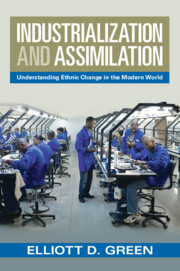Book contents
- Industrialization and Assimilation
- Industrialization and Assimilation
- Copyright page
- Dedication
- Epigraph
- Contents
- Figures
- Maps
- Tables
- Acknowledgements
- 1 Introduction
- 2 Understanding Ethnicity and Industrialization
- 3 Industrialization and Assimilation in Historical Perspective
- 4 Cross-National Evidence
- 5 Industrialization and Assimilation in Mid-twentieth-Century Turkey
- 6 Cases of Non-industrialization in Africa
- 7 ‘Cattle without Legs’
- 8 Ethnic Change among Native Americans in the United States
- 9 Ethnic Change among the Māori in New Zealand
- 10 Conclusion
- Appendix Country-Level Data Used in Chapter 4
- Bibliography
- Index
8 - Ethnic Change among Native Americans in the United States
Published online by Cambridge University Press: 18 November 2022
- Industrialization and Assimilation
- Industrialization and Assimilation
- Copyright page
- Dedication
- Epigraph
- Contents
- Figures
- Maps
- Tables
- Acknowledgements
- 1 Introduction
- 2 Understanding Ethnicity and Industrialization
- 3 Industrialization and Assimilation in Historical Perspective
- 4 Cross-National Evidence
- 5 Industrialization and Assimilation in Mid-twentieth-Century Turkey
- 6 Cases of Non-industrialization in Africa
- 7 ‘Cattle without Legs’
- 8 Ethnic Change among Native Americans in the United States
- 9 Ethnic Change among the Māori in New Zealand
- 10 Conclusion
- Appendix Country-Level Data Used in Chapter 4
- Bibliography
- Index
Summary
This is the first of two chapters on indigenous peoples in settler states. Here I focus on the case of Native Americans in the United States and show that urbanization and the demographic shift out of reservations in the late twentieth century led to widespread re-identification from more narrow tribal identities to a broader Native American identity. Census data from the 1980 US census shows a robust negative correlation at the tribal level between levels of urbanization and speaking tribal languages at home – but not between high school education and tribal language ability – which adds further evidence that it is not literacy or education that is driving assimilation. However, due to the legalization of Native American casinos from the 1980s, tribal land suddenly became economically valuable and altered the incentives for ethnic homogenization. As expected, I find evidence for an increased salience in tribal identities among Native Americans, which has in some cases led to claims for new tribal land and even new tribal identities.
- Type
- Chapter
- Information
- Industrialization and AssimilationUnderstanding Ethnic Change in the Modern World, pp. 161 - 185Publisher: Cambridge University PressPrint publication year: 2022

